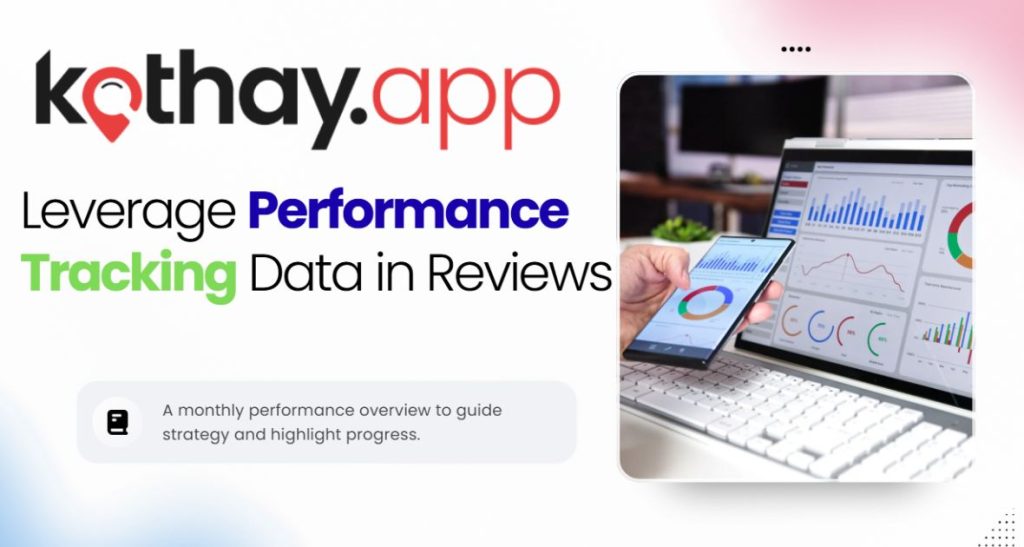AI for Employee and Salesman Tracking: A Comp
Tracking a large group of employees and sales team isn�...

Do you want to know about how to use concrete examples in an employee performance review? We often conduct these appraisals for sales teams or field reps, yet we may slip into generic phrases that lack impact. When you use specific language and metrics, your review feels clearer, fairer, and far more actionable. If you pair that with a tool like Kothay, a salesman tracking software, you’ll have real data backing the stories you tell. You’ll see how the numbers, visits, conversions and productivity trends combine with written feedback.
In this article I’ll walk through the structure of a strong review, show you sample strengths and weaknesses (with emphasis on sales roles), offer goal statements you can adapt, explain how data improves reviews and share best practices, as well as common mistakes to avoid.
If you apply these with your team and track field sales productivity improvement using Kothay, you’ll significantly raise the quality of your reviews. A performance review done poorly can feel like a checkbox. It can boost motivation, clarify expectations, and drive growth. Let’s dive in.

A review is a statement that reflects what your employee has done and what will come next. Casual feedbacks often fail to give meaningful direction to the team members. If you go through the employee performance review examples, you’ll find concrete phrasing tied to facts, behavior, and outcomes.
In sales teams especially you want clarity. For example, you can link a review to conversion rate metrics, territory visits, new accounts opened or deal size. When you track those inside Kothay, you bring verifiable data to your review. This lets you show alignment between expectations and actual performance which fosters fairness, credibility and engagement. Good examples help the employee understand precisely what they did well and where they can improve.
By using structured phrasing and examples you improve the quality of your end of year review examples or quarterly check-ins. You remove ambiguity and you give clarity. The review becomes a tool for development rather than just a judgment.
It’s best if you follow a simple 3-part structure when writing a review.
First, assess strengths. Then review improvement areas. Finally, set goals for the next cycle. This format keeps your reviews balanced and guiding without being random.
In the strength part, highlight positive behaviors, achievements, and measurable results of the employees. After that, mention behaviors that need improvements, missed opportunities, and actions to fix the issues. Before wrapping up, define goals properly. You have to say in specific, measurable, achievable, relevant, and time-bound words.
When you explain the structure to your team they understand what to expect and you reduce anxiety. Also when you capture strengths + weaknesses + goals you provide a complete picture. This approach aligns well with what research shows about effective performance reviews: they are documented, specific and future-focused.
In the next sections I’ll give sample sentences you can adapt for sales and field teams. That way you don’t start from blank.
Here are example sentences you can adapt for your employee performance review strengths examples, especially targeted to sales/field roles:
1. “Consistently exceeded monthly quota by 20% for three consecutive quarters, which contributed to team revenue growth.”
2. “Built strong relationships with key accounts in the region, resulting in a 30% increase in repeat business year-over-year.”
3. “Effectively translated product updates into client benefits during field visits, helping reduce objections and shorten sales cycle length.”
4. “Took ownership of the under-performing zone, reorganised visit schedule and improved visit frequency by 18% within six weeks.”
5. “Proactively flagged flagged high-value leads and collaborated with marketing to engage them, driving a 12% uplift in conversion rate.”
Data-Driven / Productivity
6. “Used Kothay to review daily visit logs and conversion trends, then adjusted tactics which led to a 25% improvement in conversion rate for the quarter.”
7. “Maintained route compliance of over 95% for the field team, ensuring that no major accounts were missed and aiding overall territory coverage.”
8. “Mentored two new sales reps in using the CRM and Kothay dashboards, enabling them to hit their first-quarter numbers ahead of schedule.”
When you use these kinds of sentences you make your employee performance review stronger. You tie behavior to outcomes and you provide proof. That approach aligns with the guidance from research on writing effective comments: be specific and link behaviour to results.
Now let’s shift to improvement areas. These are examples of employee performance review weaknesses that you can adapt for sales roles. The key is to phrase them constructively: mention the behaviour, show the impact, propose next steps. That aligns with performance review best practices.
Examples:
By phrasing weaknesses this way you keep the tone positive and action-oriented. You avoid vague language like “needs improvement” without specifying what and how. That aligns with guidance that feedback should be specific, contextualised and inclusive of development suggestions.
Next, let’s craft goal statements you can use for field sales and multi-level roles. These are employee performance review goals examples and they follow the SMART framework. I’ll include individual rep goals, team leader goals and regional manager goals.
When you set goals like these you give clarity, metric-focus and accountability. They tie behavioral change (e.g., using Kothay dashboards, increasing visit frequency) to measurable business outcomes (conversion rate, coverage). This helps you move from vague “improve performance” to “increase conversion by 15% by Q3”.

Now I want to explain how data can elevate your reviews. If you use a tool like Kothay salesman tracking software you capture daily field data: visits, conversions, route compliance, missed accounts, conversion rate metrics, productivity trends. That data becomes your evidence in the employee performance review.
In the review prep you can generate a report in Kothay that shows key metrics for each individual and team. Then you pull out three strengths from the data (e.g., top conversion for Q1, highest visit compliance) and two improvement areas (e.g., below average follow-up calls, missed accounts). Then you set next period goals based on those numbers. This approach keeps your review specific, measurable, and fair.
When you link review comments and goals to actual metrics you reduce bias and increase credibility. According to research, good feedback is anchored in objective examples and avoids over-reliance on recent events only. Using data also allows you to use metrics like conversion rate, visits per day, missed accounts, and other field-sales specific indicators. When the employee recognises that you used real numbers they feel the review is more factual and less subjective.
You should schedule your review work so that data from Kothay is captured ahead of time, you review the dashboards, pick out examples, and craft your feedback accordingly. This process makes your review cycle smoother, quicker and more meaningful.
At first, schedule the review ahead of time to let the employees a change to prepare a self-assesment. Allow them to share their own views on self evaluation performance review
Second, during the review focus on two-way conversation: open with strengths, then areas for growth, then jointly set goals. Make sure you align goals with business objectives and individual career aspirations. Give a clear timeline for follow-up. Provide constructive employee feedback and invite their perspective. According to research, reviews that feel like collaborative conversations increase engagement.
Third, link the review to tracking tools like Kothay: show dashboards, discuss past metrics, set future metrics, monitor progress. Fourth, document the discussion, share the review summary and schedule mid-cycle checkpoints. Prevent the review from becoming a once-a-year event. Instead make it part of an ongoing cycle. That reflects the guidance that performance management is not just annual but continuous.
Lastly, avoid generic language, ensure follow-up and keep the tone positive and forward oriented. The goal is development and alignment, not just judgement.
Now we’ll cover mistakes to avoid. Writing a review is easy to get wrong if you rely on vague language, absolutes, or only focus on weaknesses. That leads to disengagement and confusion. Research points out the risk of recency bias, overly vague praise and weak feedback statements.
Common errors include:
Example of poor vs improved statement:
Poor: “You need to improve your follow-up calls.”
Improved: “Your follow-up call volume averaged 5 per week in Q2, which is below the team average of 8; by Q4 you will increase to 9 calls per week and log outcomes in Kothay weekly.”
By avoiding weak statements and using structured language you enhance credibility and clarity. Your employee improvement areas become actionable rather than abstract. The review becomes a plan rather than a reprimand.
Let’s map a simple checklist for your review cycle. This helps you ensure nothing gets missed.
Before the review: Collect performance data (visits, conversions, metrics from Kothay), ask employee for self-assessment and prepare manager comments with strengths, weaknesses and goals.
During the review meeting: Begin with strengths, proceed to improvement areas, set goals together, and agree on timeline and follow-up. Make sure you use concrete examples and metrics.
After the review: Document and share summary, schedule mid-cycle check-ins, monitor progress in Kothay or other tracking tool, revisit goals and adjust as needed.
Using a software like Kothay helps you schedule reviews, pull relevant metrics, track goal progress and keep follow-up visible. That integrates the review cycle into your sales process and ensures the review does not become “one-and-done” but part of ongoing development.
Let me highlight why using Kothay salesman tracking software amplifies your review process. When your sales team uses Kothay in field operations you capture granular data: visit counts, conversion metrics, missed accounts, route compliance and sales productivity improvement trends. That allows you to craft sales employee performance review examples that are grounded in evidence.
With Kothay you get dashboards and alerts. You can monitor top sales skills: territory management, visit discipline, conversion rates and communication skills in sales. You can set alerts when conversion rate drops, or when visit frequency falls below threshold. You can tie employee performance review goals to those metrics and review progress in real time. That makes your reviews dynamic and forward-looking.
In the end, a review that links to actual tracking data feels credible and actionable. Your employees see the numbers, the goals and the tools. Your managers feel prepared. And the process becomes less burdensome. If you want, we can explore a demo of Kothay so you can see how to integrate field-sales tracking and review cycles in one place. I encourage you to take that next step and elevate your employee performance review process.
What is a good example of a strength in an employee performance review?
In this employee performance review, your ability to consistently achieve and exceed sales targets demonstrates excellent performance and dedication. You communicate clearly with clients, maintain strong relationships, and proactively solve issues, which positively impacts team results.
How do you write a weakness that’s constructive?
Focus on the behaviour, show its impact and propose the next step. For example: “Visit count dropped to 8 per week impacting pipeline; will raise to 10 by logging activity daily and reviewing Kothay data weekly.”
What format should employee performance review goals follow?
Goals should be SMART: Specific, Measurable, Achievable, Relevant and Time-bound. For instance: “Increase closed-lost conversion rate by 15% by Q3” meets these criteria.
How often should reviews be held?
Employee performance review can be annual, semi-annual, quarterly or continuous check-ins. Many companies use frequent check-ins and one formal review to keep things aligned.
Can tracking software improve employee performance review quality?
n an employee performance review, tracking software like Kothay gives you objective data on visits, conversions, and productivity. That data makes your feedback specific and credible, improving review quality and fairness
Now you have detailed employee performance review examples for strengths, weaknesses and goals. You understand how to frame a review with structure, use SMART goals and support your feedback with data. When you leverage tracking tools like Kothay you align review content with actual performance information and make your process more meaningful.
Your next step is to apply these review examples with your team’s actual data, run your next cycle using the strengths-weaknesses-goals format and track progress through Kothay.
If you haven’t already, check out Kothay’s features for A better review process leads to better outcomes, you’ve got this.